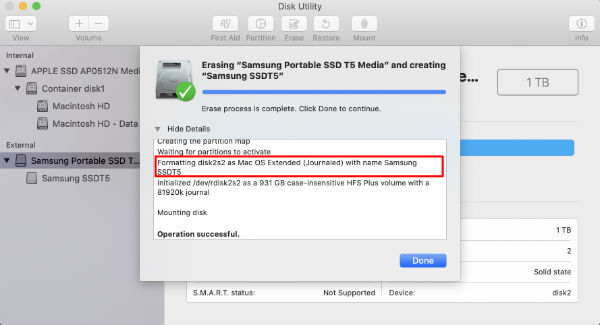
Format ssd samsung 860 evo for mac mac os#
That all seems to have worked.Īs this seems to be a common issue for both Mac OS and Windows users for the newer SSDs, it is curious that manufacturers do not ship the new SSDs pre-formatted (whether in Mac OS Extended, NTFS, FAT32 or whatever) as a formatted disk will at least be recognised as a disk when first connected to either Mac OS or Windows. I then restored to the new SSD from most recent Time Machine backup on an external disk. mine is 500GB so it came up as an unnamed 500GB disk).Īfter running eraseDisk (which takes about 5 seconds) the SSD was then "recognised" by Mac OS as a disk. When running the "diskutil list" the blank SSD just comes up as an unnamed, unformatted drive (key is to check it is the correct disk by looking at the capacity ie. Installed the "blank" SSD into the MacBook Pro, booted MacBook Pro into Recovery mode and then used Terminal prompt to format the SSD using the diskutil eraseDisk script. In the end, I did what anrah has mentioned above. With multiple form factors, the 860 EVO is ideal for mainstream PCs and laptops.

Based on 3D VNAND flash, Samsung offers enhanced read/write performance, endurance and power management efficiency. I also tried it on another notebook running Windows 10, and it was not recognised as a disk on Windows - when i plugged the dock into the Windows notebook, a message came up identifying it as a faulty USB device, but I could not see it as a disk in Disk Management on Windows. Samsung 860 EVO solid state drive is the SSD to trust.

Put the new SSD in the dock, connected dock to MacBook Pro, but the SSD was not being recognised at all in Finder or in Disk Utility. The original HDD was still working (but painfully slow), so i had intended to use a SATA III to USB3.0 dock to clone the HDD to the new SSD prior to removing the old HDD and installing the SSD.

I had the same issue - bought a new Samsung EVO 860 SSD for my early 2011 MacBook Pro 13 inch running OS X Yosemite.


 0 kommentar(er)
0 kommentar(er)
